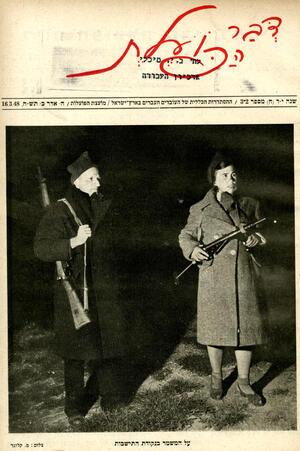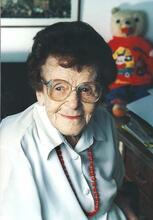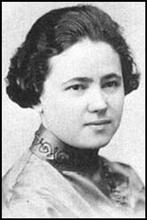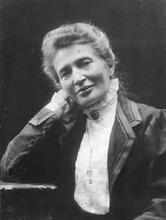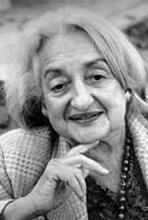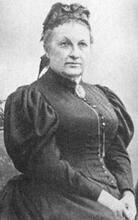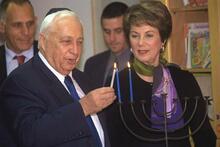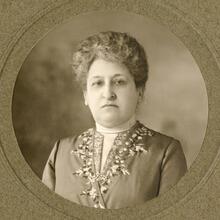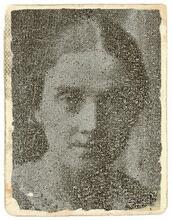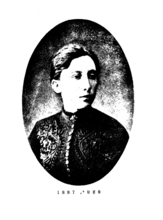Devar Ha-Po'elet
Devar ha’Po’elet was the magazine of the women worker’s movement. Founded in 1934 by Rahel Katznelson-Shazar, a prominent activist of the Council of Women Workers, the magazine was a supplement to the daily newspaper Davar; it was not independently distributed until the 1950s. The magazine was intended as an educational tool, through which the movement aimed to communicate the essential characteristics of the new Hebrew woman. Devar ha’Po’elet focused on the women worker as a separate individual, not just a wife and mother, reporting on women’s struggles in the Yishuv and abroad to improve their working conditions and attain equal employment opportunities. It also provided a vital opportunity for amateur authors and poets to publish their work. Above all, its goal was to foster unity among women workers.
Founding Devar ha-Po’elet
Devar ha-Po’elet was founded in 1934 as the organ of the women workers’ movement. It was conceived as a monthly supplement to the daily newspaper Davar, both to increase its readership and in response to the demand of the women workers’ movement, which thus realized its goal of creating a women’s magazine—a goal it had cherished since the 1920s. The women’s magazine was both officially and financially subordinate to Davar, which provided printing and distribution services. The Mo’ezet ha-Po’alot (Council of Women Workers) was responsible for its funding, which it supplied through contributions and an allocation from the Histadrut (General Federation of Workers in Israel). An independent editorial staff, led by a woman editor, was responsible for content and design.
Rahel Katznelson-Shazar, one of the most prominent activists of the Mo’ezet ha-Po’alot, founded Devar ha-Po’eletand served as its editor for twenty-seven years. A book which she edited, Divrei Po’alot, published in 1930, served as the model for the magazine. Based on the contributions of members, most of whom were not skilled writers, it was intended to provide public relations for the women workers’ movement and connect members in the Jewish community in Palestine prior to the establishment of the State of Israel. "Old Yishuv" refers to the Jewish community prior to 1882; "New Yishuv" to that following 1882.Yishuv and throughout the world. The book’s success demonstrated the need for a mode of expression for the women workers, and the magazine’s goals, format and even its name derived from it.
Intentions & Goals
Rahel Katznelson set forth its goals in the editor’s column which appeared in the first edition. “The women workers’ magazine is the magazine of the women members, intended for men and women alike. The women members will write in it, deal with its publication and imbue it with their spirit.” Its content would be dictated by the members’ needs and would reflect their family, work and communal life. It would convey information, discuss women’s problems and put an end to “the silence of the woman member.” A survey of the magazine shows that it abided by these goals during the many years of its existence.
The magazine expressed the belief that a separate movement for women workers was essential. Since Rahel Katznelson-Shazar and other movement activists conceived of the women workers’ movement as an educational movement, its magazine was intended as an educational tool for its members. Its editor saw it as a means of creating self-awareness among the women workers and imparting to them the essential characteristics of the new Hebrew woman. She believed it was necessary to fashion the woman worker as a separate, independent individual with unique needs, not just a wife and mother. The magazine’s goal was to be a source of information, support and encouragement and a platform for expressing opinions. It reported on women’s struggle to improve their working conditions, attain equal employment opportunities and transform their personal status. Its most vital goal was to encourage unity among women workers, especially when the women workers’ movement grew and diversified during the Fifth Lit. "ascent." A "calling up" to the Torah during its reading in the synagogue.Aliyah (1929–1939). Since the members felt a lack of communication both among themselves and between the rank-and-file members and the movement’s establishment, therefore the magazine discussed the major activities of the women workers’ movement. There were, however, some members of the Labor Movement, both male and female, who opposed the publication of a magazine dedicated solely to women, just as they disagreed with the idea of organizing a separate framework for women within the Histradrut.
Editorial Board
The main responsibility and burden of publishing rested with Rahel Katznelson-Shazar, who was in charge of content and execution. In this respect, it seemed that the magazine was almost a personal undertaking, though not cut off from the movement’s spirit and intentions. She was involved in all stages of its preparation: determining the contents, the subjects of the articles and coverage of events; encouraging members to write and gathering appropriate material; selecting, arranging and preparing the copy for print and, finally, going over the proofs. She had an assistant who was primarily responsible for the administrative work, and a hand-picked editorial staff whose members represented all the sectors and the political viewpoints of the women members of the Yishuv. They worked for decades, mostly as volunteers. The board included Rivkah Gurfein, Lilia Bassevitz and Devorah Dayan. From time to time, when one of them was unavailable for a long period or had died, another member from the same sector would replace her. Rivkah Guber joined the editorial board in this way in 1956. The board’s composition affected its activity. The members frequently had difficulty in freeing themselves from family and work duties. The fact that they also lived far from each other and from Tel Aviv made ongoing activity difficult. Even so, they kept to a strict schedule of monthly meetings, during which they critiqued the latest edition and planned the next one. Between meetings, they continued to deal with important issues by correspondence. Their tasks were to consult and to write, and they all did so, accepting written material from members while prodding others to write. They also covered various events in the country in the workers’ and women workers’ movements, and expressed themselves on various topics, some of them of their own choosing and others in response to Katznelson’s request. The editorial board’s activity was informal, and its members formed close, special friendships with each other and with Katznelson, who had a gift for cooperating with the board while delegating authority and encouraging their loyalty to her and to the magazine’s ideology and execution as she conceived of them.
Scope & Impact
The magazine provided an opportunity for amateur authors and poets, as well as established writers, to publish their work. Its major pride was the contributions by members who were not practiced writers, but who shared their lives and world-view with the readership. Hundreds of members wrote, mostly on their own initiative but sometimes also at the request of the editor or the board. Over the years, the magazine created a group of women who contributed to it on a more or less permanent basis.
Immediately upon its first appearance, the magazine won great acclaim. Within a short time, readers and editorial staff alike began to demand that it expand and even publish more frequently. But by the beginning of the 1940s they were unable to accomplish this because of paper rationing, which restricted all Hebrew-language newspapers in Palestine. On the contrary: beginning in 1940, the magazine was reduced in scope and appeared less frequently, though great effort was invested to maintain its original format. When the austerity times ended, the magazine resumed its previous frequency and scope of publication.
The magazine’s status as Davar supplement affected its scope and distribution. It was impossible to buy it separately, and only subscribers were exposed to it. Independent distribution began later, in the 1950s, when other workers’ newspapers were founded. It is difficult to estimate the number of readers mainly because of reading habits on the agricultural settlements. Besides its distribution in Palestine, copies were sent to all the The Day of Atonement, which falls on the 10th day of the Hebrew month of Tishrei and is devoted to prayer and fasting.Diaspora centers, mostly to Jewish women’s organizations, youth movements and training centers for the He-Halutz movement. Men and women readers praised the magazine, citing its benefits, high cultural level and its importance in their lives.
Focus of the Magazine
The magazine’s regular columns and the subjects dealt with in its pages reflect its role as a molder of opinion and an educational tool. They are also a mirror of their time. While the focus of interest varied according to the events of the time, one can say that, in general, it tended not to deal with practical instruction on women’s role in the family. It dealt with individual and communal problems and reflected women’s struggle in the Yishuv and abroad, frequently including subjects such as problems in education, immigrant absorption, women workers’ daily lives, participation in agricultural settlement and past history. The goal was to encourage a connection between national values and the workers’ movement, and especially the values of the women workers’ movement. Throughout the years of its publication, the column on “Literature and the Arts” enjoyed a special place, focusing on artistic life in the Yishuv and particularly on women artists. From the 1960s on, changes appeared, partly due to the needs of the time and partly because of the tendencies of the editorial board. Regular columns appeared dealing with home, family and fashion. Professional articles, photographs, games and quizzes were also published, writing competitions organized and questionnaires distributed.
Rahel Katznelson-Shazar retired as active editor in 1961 and was appointed chairwoman of the editorial board. Subsequent editors were Rivkah Katznelson, Shulamit Or and Zivia Cohen, who had editorial assistants and an editorial board. In 1981 the magazine changed its name to Na’amat (Working Women and Volunteers) in accord with the new name of the women workers’ movement.
Volumes of Devar ha-Po’elet, 1934–1981
Bassevitz, Lilia. If Only An Echo (Hebrew). Tel Aviv: Hakkibutz Hameuchad, 1981
Bassevitz, Lilia. Race with Time (Hebrew). Tel Aviv: N.p., 1987, 157–160
Katznelson, Rivkah. “The Harvest of the Jubilee Year.” Naamat (February-March 1984): 7–11
Shazar, Rahel and Zalman. The Two Shores: Letters 1909–1963 (Hebrew). Jerusalem: N.p., 1999
Shechter, Tamar. Li-khebosh Et Ha-lev: Life story of Rachel Katznelson-Shazar. Jerusalem: Yad Ben Zvi, 2011

